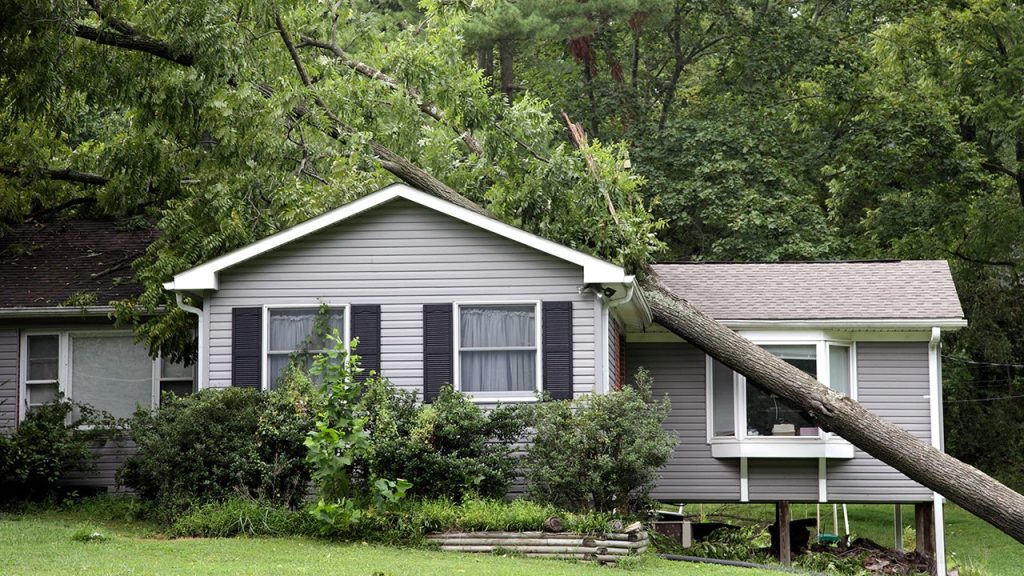Our writers and editors used an in-house natural language generation platform to assist with portions of this article, allowing them to focus on adding information that is uniquely helpful. The article was reviewed, fact-checked and edited by our editorial staff prior to publication.
Key takeaways
- Homeowners insurance policies typically cover tree damage caused by specific perils, such as fire, windstorms, lightning, theft, aircraft, non-resident vehicles, vandalism and malicious acts.
- Factors that can affect costs related to tree damage include the type of tree, how old the tree is and the type of tree care done on it.
- Homeowners insurance does not cover the removal of dangerous or diseased trees from the property, but if a fallen tree blocks the driveway or meets specific requirements, the insurance company will generally cover the cost of cleanup and tree removal.
Few features add as much beauty and value to a property as a healthy tree. But although maintaining your trees is rarely as labor-intensive as, say, weeding your garden, there are still risks to having trees. A falling tree may damage your own or a neighbor’s property. Errant limbs could impact the stability of your roof. Invasive roots might undermine a driveway or walkway. If your tree causes damage, you may wonder if you are covered by your home insurance. Bankrate’s insurance experts dive into the topic to help you understand when your homeowners insurance might cover tree damage—and when it won’t.
Key statistics and facts about trees and home insurance
- Nearly 98 percent of homeowners insurance losses were caused by property damage in 2022. Approximately 40 percent of the insured losses were due to wind and hail damage. (Insurance Information Institute (Triple-I)
- Insurance companies paid an average of $4,110 for settled tree claims. Seven percent of these claims resulted from a fallen tree. (Consumer Reports)
- If a tree located on your neighbor’s property damages your house or property, your insurance company may try to collect from their insurance company. If successful, you could be reimbursed for your deductible. (Triple-I)
- If you have particularly valuable trees on your property, you should consider how much it would cost to replace them when determining how much homeowners insurance you need. You may need to purchase a yard and garden endorsement to cover more expensive landscaping. (Triple-I)
- Standard homeowners insurance typically covers damages to trees and shrubs due to disasters or accidents like fire, windstorms, snow and ice, lightning, vandalism and theft, but this coverage is typically limited to 5 percent of the amount of insurance on the structure of your home, and insurers will also usually cap coverage for any one tree, shrub or plant. (Triple-I)
Does homeowners insurance cover tree damage?
In order for the damage to be covered, the cause of the tree falling must be due to a covered peril. Many homeowners know they can usually file a claim if a tree damages a covered structure, but you may not know that many home insurance policies also cover at least some portion of damage to the actual trees, shrubs or plants, as long as the damage was caused by a covered peril.
So if a tree falls in your yard but does not damage your home or any other structure on your property, some portion of it may be covered by your home insurance policy. According to the Triple-I, this type of coverage will generally be capped at a certain percentage of your dwelling coverage limit.
It’s important to note that most home insurance companies will not pay for tree or shrub removal unless it has fallen due to a covered peril onto a covered structure or is blocking a driveway or handicap access.
Every policy is different, however, so consider speaking with your insurance agent about what is and is not covered in your policy — before tree damage occurs.
Tree damage causes typically covered by home insurance:
- Storms
- Hail
- Snow and ice
- A fire caused by lightning (and other apocalyptic events)
Tree damage causes typically not covered by home insurance:
What is not covered by homeowners insurance when a tree falls?
Homeowners insurance often covers events that are beyond the policyholder’s control, such as hailstorms or acts of vandalism. However, it does not assist with the removal of dangerous or diseased trees from the property. Nonetheless, if a fallen tree blocks the driveway or meets specific requirements, the insurance company will generally cover the cost of cleanup and tree removal.
Does homeowners insurance cover tree damage to your neighbor’s property?
If a tree from your property falls on your neighbor’s property due to a hailstorm or other covered event, the neighbor’s policy may cover the damage. If the tree falls because the homeowner has not properly maintained it, the homeowner may be held legally liable. Homeowners should speak to their insurance agent or check their liability insurance coverage to see if it would pay for damages owed to or awarded to a neighbor.
Does homeowners insurance cover tree removal?
Homeowners insurance typically covers the removal of trees if they have fallen due to a covered peril and onto a covered structure, like your house, or if the tree is blocking an access point. Some situations where removal may be covered are:
- If a tree falls on an insured structure, such as your home itself or a garage
- If a fallen tree is blocking a driveway
- If a fallen tree is blocking a handicap-accessible ramp
Situations where tree removal is not covered under your insurance policy should be carefully considered. If your home hasn’t been damaged by a fallen tree, but you want to preemptively remove trees on your property, it is unlikely to be covered — and could even have negative consequences.
For example, if the person responsible for removing the tree is injured during the process, you may risk legal repercussions as the property owner. Bodily injury liability is one of the more infrequent causes for insurance claims, but can be one of the most costly. From 2018-2022, according to Triple-I, bodily injury and property damage was the second most severe homeowners insurance claim, costing an average of $31,690.
Insurance companies consider your justification for tree removal to determine if it will be covered. They will likely not cover the removal if you’re simply worried about your yard aesthetic and find the tree unsightly. If an insured structure was hit, insurance providers may reimburse you for tree removal up to a specified dollar amount, usually ranging from $500-$1,000. If a covered structure was not hit, your insurance company is unlikely to pay for its removal, except, possibly, in the circumstances mentioned above. It’s important to check your policy and ask your agent to determine your exact coverage.
What factors affect tree damage costs?
Some factors that may affect the cost related to tree damage include the type of tree, how old the tree is and the type of tree care you have done on it.
For example, if the tree is from a weakened species and has not been properly maintained, you may be held more responsible should it fall and cause damage. In addition, if you have a tree that is weak or diseased but you do nothing to remove it, you may be held responsible should it fall.
Another factor that affects the cost of tree damage is your location. If you live in an area prone to severe storms, tornadoes or hurricanes, your insurer may charge higher premiums for policies that cover tree damage. Similarly, if you live in an area with many sick or dying trees, you may pay higher premiums.
Does homeowners insurance cover tree damage to a neighbor’s property?
If a tree from your neighbor’s property falls on your house due to a covered risk and obstructs your driveway or meets specific criteria, your homeowners insurance might cover the resulting damage. However, if the tree was already dead or decaying and your neighbor is at fault, their insurance company should be responsible for the costs.
If a tree owned by you damages your neighbor’s house, their home insurance may cover the expenses unless the tree was already decaying or visibly damaged. In that case, your neighbor might try to establish negligence on your part for not removing the tree, and you might have to cover the costs.
How does subrogation work if my neighbor’s tree damages my property?
Subrogation is an insurance term that refers to a process where your insurance company pursues a claim against a third party, often another insurance company. It might be used if your neighbor’s tree falls on your property and damages your home or other structure.
If it appears that your neighbor’s tree fell because they were negligent in its care, they could be held responsible for the damage. Your own insurer might give you an initial payment, but they would follow up by asking the neighbor’s insurer to foot the bill. If they are successful, you would likely be reimbursed for any deductible you originally paid when your claim was disbursed.
How much to expect from the insurance company
The payout from your insurance company after you file a claim for tree damage depends on several factors, including what type of property was damaged. If a covered peril causes damage to your house, you may be eligible to receive up to the limit of your policy’s dwelling coverage, depending on how much damage was done.
You may also be able to file a claim for your personal belongings, if they were damaged, up to certain limits. Different categories of possessions have individual limits and high-value items may not be covered at all, unless you have secured additional coverage with scheduled personal property insurance. You can choose to increase these limits, but it will likely cause your homeowners insurance premium to go up.
How much you are reimbursed for your belongings and dwelling coverage also depends on whether you have actual cash value (ACV) or replacement cost value (RCV) on your policy.
If the tree itself that caused damage to your home was valuable, you might also be able to file a claim to replace it. As mentioned previously, not all policies will cover the actual tree, and the ones that do will likely have certain coverage caps in place, so you will need to look at your policy or speak with an agent to see how much is covered.
Once a claims adjuster creates an estimate for each claim category, the insurance company subtracts your policy deductible from the amount you receive. Many homeowners insurance policies also cover some additional living expenses, such as hotels and meals, up to certain limits if your home is uninhabitable while the damage is repaired.
How to prevent tree damage
It is your responsibility as a homeowner to maintain your trees properly. Damage caused by dead or rotting trees is not likely to be covered by homeowners insurance, and if a tree owned by you causes damage to someone else’s property or person, you might get sued.
Regularly assessing the health of trees and taking preventive measures is the best way to avoid tree damage. Check for hanging, broken or damaged limbs, changes in bark, leaning trees, exposed or weakened trees, poor tree structure, decay or cavities and the presence of fungus.
It’s also important to note that the location of a tree and its proximity to a structure can increase its likelihood of causing damage. Protective barriers can help prevent damage. Building a fence around the outermost part of the tree’s canopy protects against damage from digging, compacted soil or soil piling over the roots.
Here are a few other things you can do to prevent trees from causing damage to structures and property:
- Trim any trees on your property regularly, especially those with long branches.
- Check for signs your trees are dead or dying by observing a year-round lack of leaves or hollow trunks.
- Look for mushrooms, cracks or holes at the base of tree trunks to rule out rotting.
- Consider removing trees that are leaning off-center as they may have a higher potential to fall.
- Pay extra attention to trees that hang over your roof, driveway, sidewalks and streets bordering your home or power lines.
- Consider having a tree expert examine the trees on your property periodically to look for signs or disease or rot, or to recommend preventative maintenance.
Frequently asked questions
-
Finding the best home insurance company depends on what you are looking for from your policy and insurer. You may want to start your search by identifying which companies interest you based on your criteria, whether it’s top-notch customer service or affordable rates, then comparing quotes for the same coverage types and limits. Not every homeowner has the same needs, so you may want to look at several options and speak with a licensed insurance professional.
-
Diseased tree removal is generally considered routine maintenance and is not typically covered by a standard homeowners insurance policy. It is your responsibility to track the health of your trees and treat them when needed.
-
A roof can be expensive to replace, but most standard policies will cover tree damage to a roof if the following perils caused it:
- Fire or lightning
- Windstorms and hail
- Explosions
- Riots, vandalism or theft
- Damaged caused by aircraft or vehicles
- Smoke
- Volcanic eruptions
- Falling objects
- The weight of snow, ice or sleet
In most cases, roof damage from a tree felled by floods or earthquakes is not covered. It is typically a good idea to consider purchasing flood insurance and/or earthquake insurance if you live in an area prone to either. Note that insurance companies will typically only cover your roof if it is well-maintained. If you are unsure of the specific coverages included in your policy, turn to your agent or insurance company for clarification.
-
Arbor Day Foundation finds that planting trees in residential areas can increase property values anywhere from 3 to 15 percent. Trees can really spruce up a neighborhood and appeal to potential buyers.Removing dying or rotting trees can also increase the value of your home by eliminating that risk for future residents, according to Realtor.com. Remember that the cost of removing trees, even if diseased or rotting, is considered routine care and maintenance and is usually not covered by insurance.
-
It’s typically a good best practice to select trees that don’t forget their roots — literally. If you’re considering planting a tree or evaluating the type of tree on a property you’re looking to buy, look for healthy, strong roots. Bonus points if the tree is relatively low-maintenance. Some of the best types of low-maintenance trees include oaks, maples, hickories and elm trees, according to Realtor.com. You might want to consult with a landscape expert to determine what trees are the best for your climate and property type.
-
Experts advise picking trees best-suited for your environment and considering their native location. For example, non-native tree types like black locusts and box elders, native to the Southeast and Central/East regions, generally wouldn’t thrive in the desert climate of the Western U.S., according to Realtor.com. It’s also usually a good idea to avoid trees that attract invasive species of insects or trees with invasive roots. These types of trees can bring unwelcome visitors to your home or shift the foundation of your house entirely. Trees with these types of roots include willows, hybrid poplars and silver maples, all of which have the potential to invade your sewer lines and drain pipes. Again, speaking with an ISA Certified Arborist or landscape professional might be the best idea to determine what trees are right for your home.
-
In most cases, it would be your car insurance rather than your home insurance that paid for damages from a tree falling on your car. Generally, this would be paid out of your comprehensive coverage, an optional but common type of insurance that often covers damage caused by anything other than an accident. If, however, the tree was on your neighbor’s property, and it was determined that it fell due to their negligence, their homeowners insurance might play a role in paying for damages.
Read the full article here










